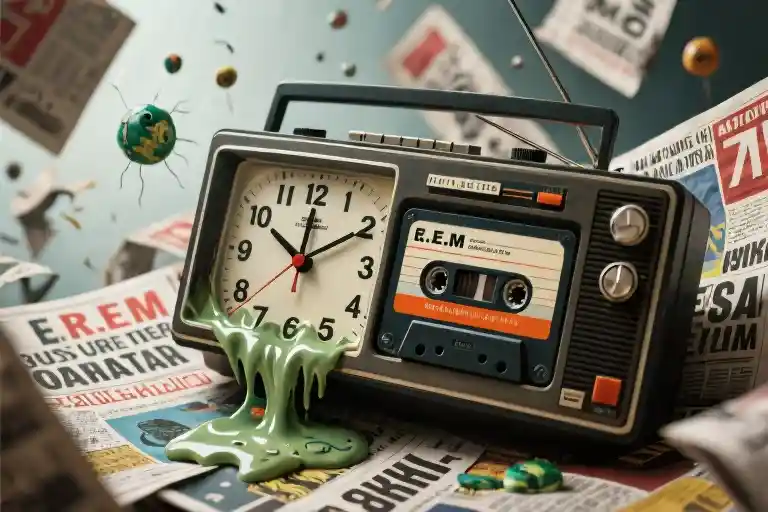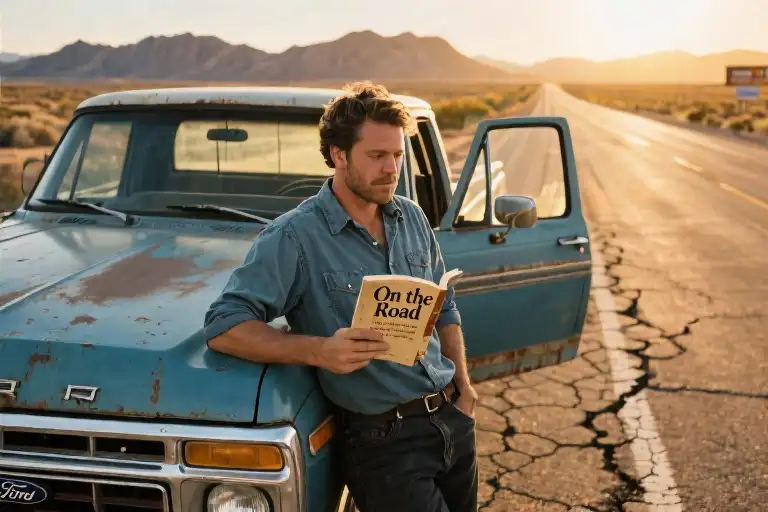The first time I heard R.E.M.’s “It’s the End of the World as We Know It (And I Feel Fine),” it was 1987 and I was lip-syncing into a hairbrush in my middle school bedroom. Like every American teenager with a clock radio that year, I’d memorized the rapid-fire lyrics – or at least my best approximation of them between Michael Stipe’s mumbles and my own breathless attempts to keep up. What mattered wasn’t understanding the words, but riding the song’s infectious energy, that peculiar blend of urgency and indifference captured in its closing refrain: “And I feel fine.
Three decades later, those same lyrics demand closer inspection. Rolling Stone would eventually rank it among the “50 Greatest Protest Songs,” though protest implies clarity of message – something Stipe famously resisted. When pressed about meanings, the opaque lyricist would shrug: “It’s just a song.” Yet listening today, as climate reports scroll alongside TikTok dances and doomsday preppers stock bunkers while Amazon delivers same-day groceries, the song feels less like nostalgia and more like a cultural X-ray.
The genius of R.E.M.’s apocalyptic anthem lies in its deliberate ambiguity. Is it:
- A genuine warning siren about societal collapse?
- A satire of American distraction amid crisis?
- Or something more unsettling – a mirror reflecting our collective ability to acknowledge disaster while continuing business as usual?
This tension between awareness and avoidance defines what I’ve come to recognize as America’s “apocalypse paradox.” We’re a nation that simultaneously:
- Binge-watches dystopian dramas
- Stocks emergency kits at Costco
- Yet acts shocked when actual crises (pandemics, insurrections, wildfires) occur
Stipe’s stream-of-consciousness lyrics – name-dropping Leonard Bernstein, hurricanes, and birthday parties with equal weight – perfectly capture this dissonance. The cultural references function like a 1980s Twitter feed: fragmented, overwhelming, and strangely mundane even when describing catastrophe. That the song remains relevant speaks less to prophetic vision than to our persistent national character – one that Trump-era politics would later amplify with campaign-trail chants of “American Carnage” set against golf-course photo ops.
Perhaps this explains why millennials now introduce their children to the song through TikTok challenges rather than protest marches. The lyrics work equally well as:
- A prepper’s manifesto (“Save yourself, serve yourself”)
- A capitalist’s anthem (“It’s time I had some time alone”)
- Or a social media user’s mantra (“Listen to yourself churn”)
In an era where every crisis becomes content, maybe feeling fine about the end isn’t irony – it’s the only survival mechanism we have left.
Decoding Stipe’s Lyric Labyrinth
Few songs in rock history have sparked as much interpretive freefall as R.E.M.’s 1987 rapid-fire anthem. What begins as a seemingly random collage of names and phrases—Leonard Bernstein, Leonid Brezhnev, birthday party—gradually reveals itself as a carefully constructed Rorschach test for American anxiety.
The Bernstein Paradox
That opening invocation of the legendary conductor serves as our first interpretive fork in the road. To some, it signals the collapse of high culture (Bernstein’s 1989 death coinciding with the song’s cultural saturation). Others hear sly commentary on liberal elitism—the symphony crowd clinking champagne glasses while Rome burns. Stipe himself, when pressed in a 1988 Spin interview, only smirked: “It scans well.”
Consider these competing readings of key passages:
| Lyric Snippet | Interpretation A | Interpretation B |
|---|---|---|
| “Birthday party” | Celebration amidst chaos | Consumerist distraction |
| “Six o’clock – TV hour” | Media desensitization | Emergency broadcast |
| “A tournament, a tournament” | Political theater | Literal sports escapism |
The Misheard Gospel
The song’s deliberate opacity birthed generations of mondegreen interpretations (those charming misheard lyrics). Where Stipe sings “book of love,” millions swore they heard “hook above”; his “yell subprime” became “year of the vine” in dorm rooms nationwide. This phenomenon isn’t just amusing—it proves the lyrics function like musical Rorschach inkblots, revealing more about the listener than the artist.
Michael Stipe’s creative process, as described in a 1991 Rolling Stone profile, leaned into this ambiguity: “I’d sing nonsense syllables until phrases emerged from the phonetic soup. The meaning comes later—if at all.” This anti-explanatory stance transforms each performance into a collaborative act of meaning-making between artist and audience.
Rhythm as Meaning
The musical arrangement itself reinforces this interpretive free-for-all. That breakneck 6/8 tempo (186 BPM) mirrors the overwhelm of information overload—an ’80s analog to our modern Twitter scroll. Bill Berry’s drum fills arrive like emergency alerts, while Peter Buck’s jangly arpeggios suggest both alarm bells and carnival music. Even the title’s parenthetical “(And I Feel Fine)” hangs in perfect ambivalence—is that reassurance or resignation?
As we’ll explore next, this lyrical hall of mirrors didn’t emerge in a vacuum. It reflects a distinctly American cognitive dissonance that stretches from Cold War bunkers to climate change denial—a tension between knowing the world is ending and acting like everything’s business as usual.
The Psychology of American Apocalypse Culture
That frantic REM song from our youth wasn’t just catchy – it captured something fundamental about the American psyche. We’ve always had this peculiar relationship with doomsday, simultaneously convinced of impending catastrophe yet behaving like nothing could ever truly disrupt our way of life.
Our Historical Pattern: Sounding Alarms Then Hitting Snooze
From the duck-and-cover drills of the Cold War to the Y2K panic buying sprees, Americans have perfected the art of apocalyptic anticipation followed by business-as-usual. Remember stocking fallout shelters while still planning backyard barbecues? Or how we collectively fretted about the millennium bug while maxing out credit cards on frivolous holiday purchases?
This pattern repeats with eerie consistency. During the 2008 financial crisis, foreclosure signs sprouted across suburbs as families continued leasing SUVs. More recently, climate change warnings crescendo while McMansions still multiply in wildfire zones. And who could forget the surreal spring of 2020, when we debated pandemic precautions between Netflix binges and Amazon deliveries?
The Science Behind Our Split Personality
Psychologists call this phenomenon optimism bias – that stubborn human tendency to believe we’re personally exempt from statistical probabilities. Studies show 80% of Americans suffer from this blind spot, especially regarding large-scale disasters.
Meanwhile, sociologists identify disaster porn as our cultural addiction to consuming catastrophe as entertainment. We compulsively refresh doomscrolling feeds while emotionally detaching from the content. The Pew Research Center found 75% of Americans believe the future looks grim for coming generations, yet consumer spending continues breaking records year after year.
A Cultural Contrast That Speaks Volumes
Compare how different societies approach catastrophe. Japanese disaster films like Shin Godzilla portray bureaucratic failures with solemn gravity. Meanwhile, Hollywood gives us 2012 with its wisecracking heroes outracing CGI tsunamis – popcorn entertainment where the world might end but the one-liners never stop.
This cultural dissonance explains why REM’s lyrics resonate differently here. When Michael Stipe rapid-fire lists collapsing systems while repeating “I feel fine,” he perfectly encapsulates our national coping mechanism: name every looming disaster, then shrug and turn up the radio.
The Data Behind Our Delusion
Recent surveys reveal:
- 68% of Americans worry about societal collapse
- Yet 61% admit making no preparedness efforts
- Credit card debt hit $1 trillion during pandemic lockdowns
- 55% of climate-concerned citizens still take frequent leisure flights
These numbers paint a portrait of a society that intellectually acknowledges vulnerability while behaviorally acting invincible. Much like Stipe’s narrator cataloging disasters with cheerful detachment, we’ve mastered the art of cognitive dissonance.
Perhaps this explains why “It’s the End of the World as We Know It” became an unlikely anthem. Not because we related to its warnings, but because we recognized ourselves in its blasé refrain – that very American ability to survey the crumbling world and still say, with perfect sincerity, “I feel fine.”
Echoes from 1987 to the Trump Era
When Michael Stipe sang about “birthday parties, cheerleading squads” amidst apocalyptic imagery, he captured a peculiarly American duality – our ability to party through impending doom. This cultural dissonance reached its crescendo three decades later when Donald Trump stood at his inauguration podium describing “American carnage” while the nation simultaneously binge-watched Netflix and Instagrammed avocado toast.
The Party Never Stops
The song’s frenetic references to pop culture ephemera (Leonard Bernstein, Leonid Brezhnev) mirror our current media landscape where political crises compete with celebrity gossip for attention. Trump’s presidency became the ultimate manifestation of this phenomenon – his administration’s daily scandals would trend alongside Kardashian selfies, creating what media theorists call “context collapse.”
Social media platforms perfected this dystopian carnival. During the Capitol riots on January 6, Twitter users live-tweeted the insurrection while simultaneously sharing TikTok dances and Amazon shopping links. The song’s closing refrain – “It’s time I had some time alone” – feels particularly poignant in an era where we’re never truly alone with our thoughts, yet more isolated than ever.
Preppers vs. Influencers
Contemporary culture has bifurcated into two extremes: the “doomscrollers” stockpiling survival gear for climate collapse, and the Instagram jet-set crowd posting #YOLO content from Maldives resorts. REM’s lyrics anticipated this schism – the verses catalog societal collapse while the chorus insists “I feel fine.”
This psychological split manifests in startling statistics: 68% of Americans worry about climate change according to Yale’s Climate Opinion Maps, yet SUV sales hit record highs in 2022. We’ve perfected the art of cognitive dissonance, using consumerism as both distraction and comfort – much like the “cheerful nonchalance” Stipe might have been critiquing.
The Great American Paradox
What connects 1987 to today is our unique national pathology: the ability to maintain simultaneous beliefs in imminent catastrophe and personal exceptionalism. Cold War nuclear drills coexisted with suburban mall culture; pandemic lockdowns saw Zoom meetings bookended by online shopping sprees.
Perhaps the song’s enduring relevance lies in its refusal to resolve this tension. Like Stipe’s deliberately opaque lyrics, America’s relationship with disaster remains open to interpretation – are we whistling past the graveyard, or genuinely convinced our party will never end? The answer, much like the meaning behind REM’s classic, depends on who you ask.
When We Sing “I Feel Fine” Today
Three decades after its release, REM’s apocalyptic anthem still echoes through our collective consciousness with unsettling relevance. That final declaration—”And I feel fine”—hangs in the air like a Rorschach test for our times. Are we, like the song’s narrator, maintaining ironic detachment as systems crumble? Or have we perfected the art of cheerful denial?
The Endless Loop of American Apocalypse
The cultural DNA that made this song resonate in 1987 still replicates itself today. We’ve simply traded:
- Nuclear drills for active shooter trainings
- Y2K panic for climate change doomscrolling
- Cold War rhetoric for “American Carnage” speeches
Yet the behavioral paradox remains: 72% of Americans believe the country’s on the wrong track (Pew Research), while consumer spending hits record highs. This cognitive dissonance plays out in our Spotify playlists—where “It’s the End of the World” sits alongside shopping podcast subscriptions.
Your Turn: The Lyrics That Haunt You
Which fragments of Stipe’s rapid-fire prophecy feel most prescient today? For some, it’s:
- “Six o’clock, TV hour” → the 24/7 news cycle’s doom loop
- “Save yourself, serve yourself” → pandemic hoarding
- “Birthday party, cheesecake” → performative normalcy
Share your lyrical lightning rod using #REMEndTimesReflection. We’ll compile the most revealing responses into a crowdsourced cultural diagnosis.
Keep Listening, Keep Questioning
As the song fades out with its ambiguous affirmation, consider this: maybe the true test isn’t whether we decode Stipe’s lyrics correctly, but whether we can break the cycle of knowing the world’s ending yet feeling inexplicably fine.
▶️ Listen on Spotify | 📚 Further Reading: Apocalypse Never: Why Environmental Alarmism Hurts Us All by Michael Shellenberger





